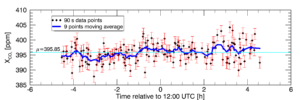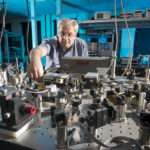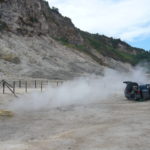Laser Heterodyne Spectro-radiometry for CO2 sounding

Diurnal evolution of dry total column of CO2 retrieved from the LHR measurements.
This project focuses on the demonstration and assessment of thermal infrared laser heterodyne spectro-radiometry for the remote sensing of carbon dioxide. Theoretical concept studies based on modelling have indicated Laser Heterodyne Radiometers (LHRs) can contribute to improving remote sensing of carbon dioxide in the thermal infrared, on-board a variety of platforms from ground-based to space-based. During the project, ground-based measurements will be carried out and compared against theoretical modelling in order to fully assess the instrument technology and devise forward steps toward low cost, miniature autonomous carbon dioxide remote sensors. High precision, high temporal resolution, total column measurements and altitude resolved mixing ratio profiles providing lower troposphere information are to be demonstrated. As one of the most important greenhouse gas, improved carbon dioxide measurements are needed to address both science questions related to the carbon cycle and to develop emission measurements services. Along with the LHR miniaturization developed under previous CEOI-ST support, the objective of the project is to significantly impact on both science and EO services by making cost effective, small, multi-platform and versatile high performance remote sounders.
Funded by the UKSA Centre for Earth Observation Instrumentation.

 Previous Post
Previous Post Next Post
Next Post